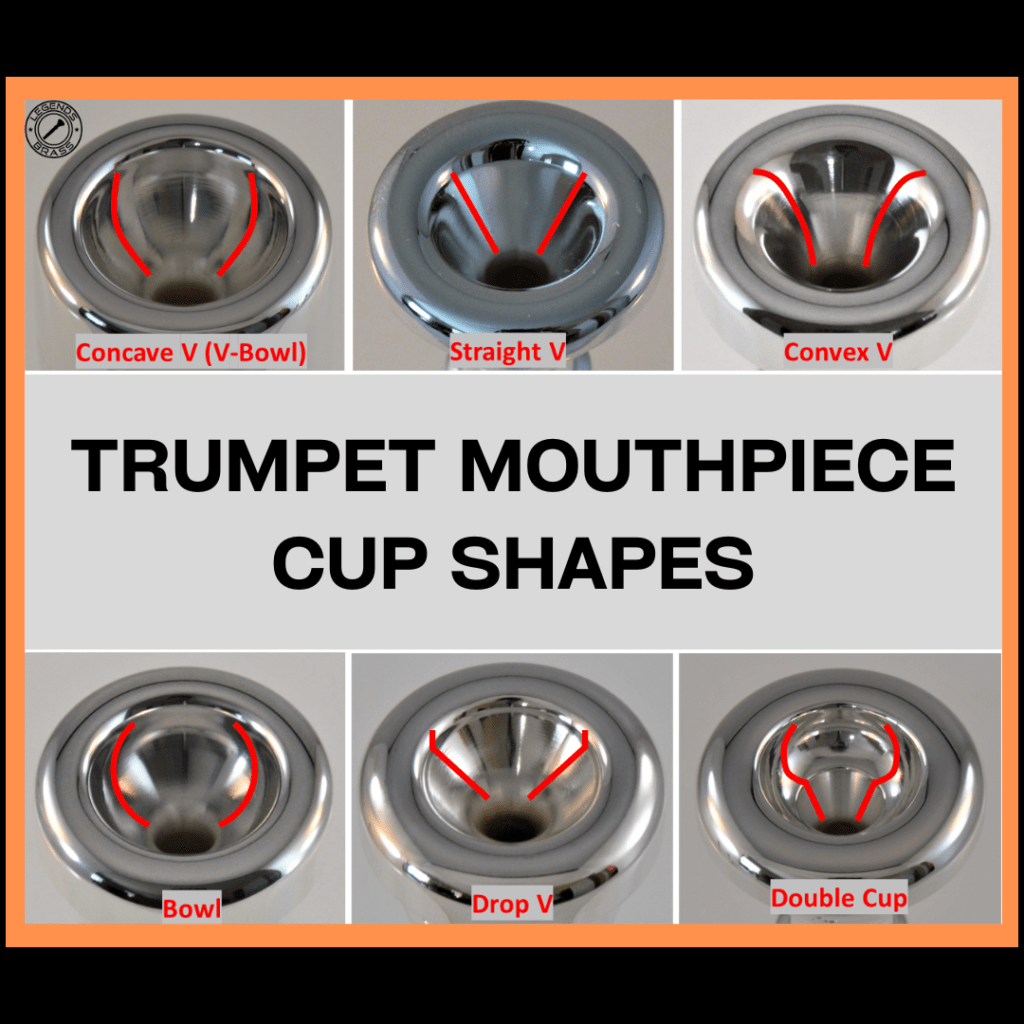Trumpet mouthpiece cups come in a variety of shapes. Understanding the different options will help you choose the one that will work best for you.

There are two basic shapes for trumpet mouthpiece cups: U shape (also referred to as C-type cup or Bowl) and V shape.
The U-shaped cup will have more air turbulance at the bottom, near the throat, as the air travels around the curve and back toward the lips. This turbulance creates a coarseness or brilliance of tone, and projects well. A shallow U cup will have more brilliance and projection, but it might cause the player to “gas out” or become exhausted from working harder to move the air into the throat. A deep U cup with more cup volume allows the air flow to slow down and the tone to darken, but the sound could become less responsive and more dull.
On the other hand, the V-shaped cup will not have a lot of turbulance near the throat. A shallow V cup allows the player to move air quickly and freely into the throat, as needed for playing in the upper register, but the tone could be thin due to the small cup volume. The player’s lips could even “bottom out” if the V is too shallow. A deep V cup creates a smooth, mellow sound with lots of core, but the player could struggle with the upper register due to the effort required to move the air quickly without a lot of resistence.
If the shape of the cup is a simple U or V (such as the “Bowl” shape or “Straight V” in the picture above), the cup depth, rim shape and width, throat size and backbore can be used to balance resistance and achieve the desired tone. For example, a medium shallow V cup with a tighter throat might provide just the right amount of resistance to support upper register playing, without sacrificing a full sound.
Sometimes the cup shape is a modification of the U or V, such as the Concave and Convex V cups in the picture above. The Concave V cup (also called a V-Bowl) has less turbulance than a U shaped cup would, but has more cup volume than a Straight V. The Convex V cup has both less turbulance and less cup volume than a Straight V would. Concave and Convex V cups are both used by players who want a big sound in the upper register with lots of projection. Similarly, the volume of a U shaped cup is increased as the roundness of the sides increases.
Sometimes a hybrid of both cup shapes is used. The Drop V cup shown in the picture above has qualities of both the U and V shaped cups. The upper part of the cup (the “drop”) increases the total cup volume slightly, and the air moves freely through the lower V shaped portion of the cup. This is a good combination to support upper register playing without sacrificing a big sound. The Double Cup has even more of the qualities of the U shaped cup at the top, which creates a brilliant sound, but there is enough air flow toward the throat to have a big sound and good projection in the upper register. The Double Cup is often used for mariachi music, where the lead trumpet part is very technical and usually in the upper register, but projection over the rest of the group is needed.
There are no hard and fast rules in the world of mouthpieces because everyone’s embouchure is unique. Each variation in rim, cup, throat and backbore can create nuanced differences in the sound produced. This is why many players find themselves on a “mouthpiece safari”, trying one after another after another. A better understanding of the effects of cup shape can help you navigate the challenge of finding the best mouthpiece to achieve your desired sound. It may not end your safari, but it will at least make the trip shorter and more predictable!
Be sure to follow us on FaceBook and Instagram! Just click the buttons to the right!
Legends Brass Models to try:
Bowl: 5C, Arturo Sandoval, Broadway Lead, CB, Corps Lead, DeArmond, Matador, Pellegrini Philharmonic
Straight V: Funkin Groovin, Heim 1, Heim 2, Lightning, MF FBL TXS, MF FBL TS, MF FBL TM, MF FBL TD
Concave V (or V-bowl): BB, Best, JT RS .654, MD, MF HG, Screamer
Convex V: JT MF, JT MF2, JT MF3, JT MF Master, JT MF Monster, JT Super C, MF1, MF6
Drop V: L-BL6, Stratosphere, W. Byrd, Wise
References:
Wikipedia. n.d. Mouthpiece (brass). Retrieved 5/17/19, from https://en.wikipedia.org/wiki/Mouthpiece_(brass).
Stork, Phyllis. 10/15/2015. Stork Custom Mouthpieces. Retrieved 5/16/19, from https://storkcustom.com/the-basics-of-rim-shape-and-cup-shape/ .








